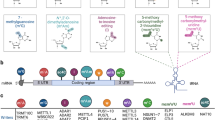Abstract.
The structural and enzymatic properties of RNase 4 are reviewed. This RNase shows a much higher interspecies similarity (approximately 90%) than the other members of the RNase A superfamily. The enzyme is ubiquitous, with the highest amounts present in liver and lung. Its unique uridine specificity results from alterations in and around the pyrimidine-binding site. In particular, the shortened C-terminus and the side chains of Phe-42, Asp-80 and Arg-101 appear to be involved. RNase 4 binds tightly to the intracellular RNase inhibitor, with a K d of 4 × 10−15 M.
Similar content being viewed by others
Author information
Authors and Affiliations
Additional information
Rights and permissions
About this article
Cite this article
Hofsteenge, J., Vicentini, A. & Zelenko, O. Ribonuclease 4, an evolutionarily highly conserved member of the superfamily. CMLS, Cell. Mol. Life Sci. 54, 804–810 (1998). https://doi.org/10.1007/s000180050209
Issue Date:
DOI: https://doi.org/10.1007/s000180050209




